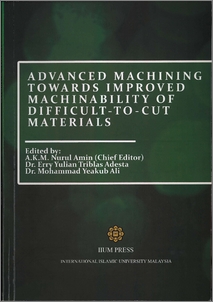Amin, A. K. M. Nurul and Syaban, M. and Mahmud, Md. Asif
(2011)
Elimination of burr formation during end milling of Polymethyl Methacrylate (PMMA) through high speed machining.
In:
Advanced Machining Towards Improved Machinability of Difficult-to-Cut Materials.
IIUM Press, Kuala Lumpur, Malaysia, pp. 233-237.
ISBN 9789674181758
![[img]](http://irep.iium.edu.my/style/images/fileicons/application_pdf.png)  Preview |
|
PDF (Elimination of burr formation during end milling of Polymethyl Methacrylate (PMMA) through high speed machining)
- Published Version
Download (554kB)
| Preview
|
Abstract
A burr is a raised edge or small pieces of material remaining attached to a workpiece after it has
undergone machining. The Burr, Edge and Surface Technology (BEST) Division, the Society of
Manufacturing Engineers defines a burr as “an undesirable projection of material that results
from cutting, forming, blanking or shearing operation [1].
The first stage, chip formed in front of the cutting tool with a positive shear angle, φ. The plastic
zone around the primary shear zone is extended towards the work edge when cutting tool
advance toward the work edge.There are four basic types of burr that have been defined by
researchers which are: poisson, roll-over, tear burr and cut-off burr [2-3]. The four specific types
of burr are:
Roughness refer to the small, finely spaced deviations from the nominal surface, which is
determined by the material characteristics and the process that formed the surface [4]. The
theoretical surface roughness, �� can be estimated using the following equation [5]
�� = ��
� / 32(R ± ���� / π) (1)
Where �� is the surface roughness, �� is the number of teeth on the cutter, R is the radius of the
cutter, �� is the feed per revolution and the (+) sign refers to up-milling and the (-) sign refers to
down milling.The above equation does not consider many factors that in reality can affect the
surface roughness. For this reason the surface roughness will generally be higher than that
predicted by Eq. (1). Statistical models that include such factors as depth of cut and spindle
speed in addition to feed rate have been developed [6].
Actions (login required)
 |
View Item |


 Download Statistics
Download Statistics Download Statistics
Download Statistics